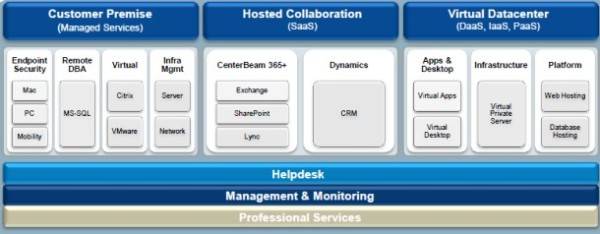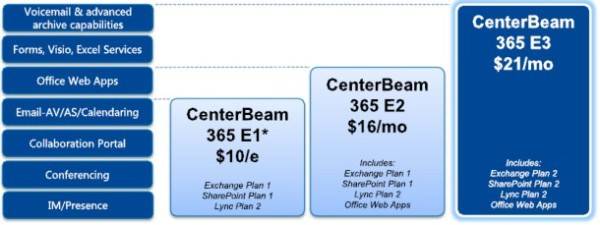The theory goes like this: There is a certain class of mid-range enterprise customer — less than a Fortune 500, more than a rented garage — for whom “the cloud” is essentially about one thing and one-thing only: the self-service aspect. They see cloud architecture as enabling them to move everything — their storage, their processing, their applications, their IT management — off-premise.

They see the cloud as having a turnkey. Twist the wrist, and it just works.
In practice, you can’t just make your data center into a virtual machine, package it up, and ship it to Seattle. Moving an entire business of one or two thousand employees or so into a self-contained cloud typically isn’t done without some level of transition. In the case of moving to Microsoft services like Office 365, for example, it means obtaining licenses to the most current Microsoft on-premise software, including Office 2010.
“We believe that the mid-market has the same types of issues that an enterprise organization does,” says Shahin Pirooz, CTO of cloud service provider CenterBeam. “They just don’t have the funding, wherewithal, or resources to solve them.”
The cloud before “the cloud”
CenterBeam is not a startup. It has actually been an online host of business services and applications since 1999, well before the fluffy “cloud” moniker was coined. This week, the company launched what it’s marketing a full-service cloud collaboration suite. Obviously designed to compete against Office 365, its title is CenterBeam 365+.
However, it’s not a feature-for-feature match-up with O365. Rather, it offers the basic CenterBeam value proposition (“we host what you want us to host”) updated for the cloud era.

“We do full professional services to help [the customer] transition to this environment, and in many cases, our customers are having us manage this infrastructure for them,” Pirooz says. A customer may run custom Web apps through the CenterBeam PaaS component, or virtual server instances through the IaaS component. The cloud database (“DaaS”) is a full instance of SQL Server, complete with data warehousing, modeling, and reporting services (SSRS), allowing as many databases per instance as the customer may require, which in turn can enable any ERP application the customer needs. Application virtualization through Citrix is possible through CenterBeam’s Managed Services component.
“If we look at the continuum of the consumer class all the way to the full enterprise, the solutions that are in the marketplace today that are cloud-based, consumer-class [tell the customer], ‘Here’s the technology; figure out how to integrate it yourself,'” remarks Pirooz. “They’re vanilla, one-size-fits-all solutions that may be scalable, but allow very little customization. It’s a black box in terms of how you integrate with it. By contrast, you have solutions from the big three-letter acronyms out there for the enterprise, that are build-many, customize-each-time instead of build-once, use-many.”
In-between these two realms is the customer class that CenterBeam is targeting. “We have a mantra called flexible lockdown,” the CTO tells us, “which allows the customer to bring their security policies and practices to the table. If they don’t have them, we’ll help them develop some to meet their needs. It’s not a restrictive environment where they can’t do any customizations. It is pre-built and it is scalable, so it has all of the bells and whistles of a fractional-ownership, multi-tenant, SaaS-based model, on top of which are several layers of enterprise capabilities that allow the customization.”
The move without the migration
The objective is not to move the customer into an environment with which users there would be unfamiliar. The customer makes all the final decisions about which services to deploy, to whom, and how old they may be — going back to Office 2003. For some customers, CenterBeam, a migration to the cloud can’t simultaneously be a change to their way of life. By contrast, Office 365 requires adoption of Office 2010.
Pirooz gave us some examples: One CenterBeam customer had firmly decided to follow the policies of the Federal Rules of Civil Procedure (FRCP), which stipulates that e-mail messages older than 90 days must be destroyed, not just deleted, from the server. Not every organization treats the FRCP as law, but this one did. Only later editions of Microsoft Exchange enable support for the letter as well as the spirit of the deletion rule. CenterBeam chose not to argue and enabled full destruction as per the customer’s policy.
Another example: CenterBeam 365+ includes fully hosted SharePoint. However, as CenterBeam CMO Karen Hayward tells RWW, many organizations’ concept of collaboration remains rooted to the .PST files produced by Outlook. “The reality is that, we say to [customers], ‘Come as you are,’ and you can continue to use your .PST files, which we will support… and when you’re ready to go to SharePoint, we’ll take you there.” Customers can implement custom SharePoint code outside of a sandbox, unlike Office 365 which implements sandbox limitations.
Key to cloud services’ ease of use is single sign-on, where the user’s local identity is trusted on all remote services without having to sign on again using a different password. That’s possible with Microsoft services, Pirooz points out, but only if the customer adopts Active Directory Federation Services (AD FS) on its servers. That requires the complete promotion of the domain functional level to Windows Server 2008 standards, and that changes the ballgame for underlying software, including applications that utilize their own sign-on models.
“Microsoft says, if you’re under 100 seats, don’t even consider federation because it’s too much work,” reports Pirooz, “and it’s not worth the effort. If you’re over 500 seats, Microsoft says you should consider dedicated Exchange instead of hosted multi-tenant.” In-between lay a pocket of potential customers who, again, he says don’t have the IT wherewithal to manage AD FS. “I feel like Microsoft’s True Single Sign-on model is something that really lacks in substance, in that I don’t think there will be a huge adoption of it unless you’re a large scale enterprise organization, and go dedicated [Exchange] and want to use federation.”
The company utilizes a simple, three-tier price chart per user, using Microsoft’s Office 365 pricing model as a template. CenterBeam 365+ service begins at $10/user/month for an Exchange e-mail, Lync communication, and SharePoint collaboration. The second tier, called “E2” and priced at $16/user/month, adds Office Web Apps which include browser-based access to Exchange. The top tier, at $21/user/month, adds voice mail capability with Outlook and Exchange.

CenterBeam’s next conference appearance will be December 4-6 at the CIO Mid-Market Summit in Scotsdale, Arizona.










